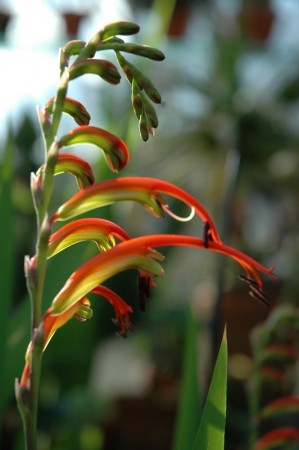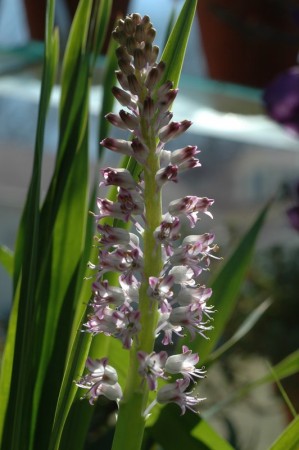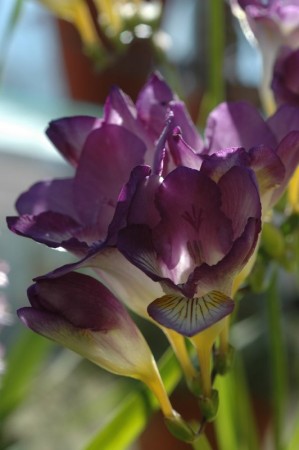Let us talk about lust. I’m speaking of the insidious longing that grips a girl who pretty much has it all — botanically speaking. I’m talking about the urge that makes someone yearn after her neighbor’s bulbs. It’s depraved. It’s desire run amok. It’s sick. And Debra Lee Baldwin — with her talk of hundreds (maybe thousands, she was vague about it) of babianas in her California yard has only fueled the fires. Because right now (Lord have mercy), I’m coveting my neighbor’s greenhouse and its contents.
Right down the street (hold me back from pushing the SAVE button and jumping into the car again to take yet another peek) there’s a greenhouse. And in that greenhouse resides several containers of jewel-like babianas brandishing their wands of deep royal purple flowers in a color that petunias only try to achieve. But that’s just for starters. Because kicking up their heels and blooming bloody murder are umpteen other South African bulbs. A whole herd of them. We’re talking Connecticut here. In the chilly shadow of the Berkshires. And it’s winter still.
But let me set the stage to give you the full impact of the cosmic contrast. Outdoors: Think bleak. Think mud that slides flotsam from 4 feet of snow as it recedes. Broken branches, whipped trees, hedges splintered into matchsticks, voles running rampant. You get the grizzly picture. Bring up all the shabby, tattered, weary shades of brown you can imagine and apply them here. You got it.
Now slip and slide in the mud, skid for the last few feet and kick open the frozen door of a greenhouse. Your arrival is announced by a vapor cloud where the cold air mingles with the warmth inside. Your skin soaks up the humidity with the thirst of a nomad in the desert. Your eyes adjust to the glistening glad hand of a spectrum that you haven’t seen in months (unless you’re Debra). And you emit the sigh of the lost soul who found her Promised Land. You are surveying a panorama of watsonias, chasmanthes, lachenalias, and species freesias wherever you turn. Now do you forgive my descent into desire?
I confess. The greenhouse’s caretaker, Rob Girard, is a friend of mine. He sees to the wants and needs of Peter Wooster’s botanical collection and adds to its numbers on a regular basis. The fact that I’ve got a few modest South African bulbs in my puny collection is directly due to Rob’s influence. My holdings are only the pitiful shadow of his magnificent harem of brightly colored creatures that make winter livable and (dare I say) delightful.
If a genie granted me only three South African bulbs, I’d start with lachenalia. Do you agree? In my experience, lachenalias are a cinch and they are easy to find, try Brent & Becky’s Bulbs . Lachenalias come in the full spectrum of colors and some add fragrance to the brew as well. Beyond that, it’s a toss up between the bright orange, dragon-like flowers on Chasmanthe bicolor, the Halloween orange-hued spikes of Cyrtanthus mackenii (I named a particularly bright cultivar ‘Hobgoblin’ back when I was at Logee’s Greenhouses), and the pink poker-like spires of Veltheimia bracteata. (I know…that’s four — genies are meant to be pushed beyond their limits, right?) Of that group, only the chasmanthe has been slightly challenging in a home windowsill environment.
I believe in going to the top. So I sought advice from a botanical garden expert when I first began dabbling in South African bulbs. He insisted that they require ardent sun, cactus-like soil, and nearly non-existent water. The sun part was on target. But too much drainage from a gritty soil only seems to stress them in my home. Mine hate to dry out in a home environment. Anyone else have feedback on this?
After the mud moment, spring will come with all its attendant bulbs. The South African bulb event will slip away, and I’ll move on to different dalliances. But that’s the beauty of South African bulbs. You just store them over the winter for future lust. A convenient affair, no?





